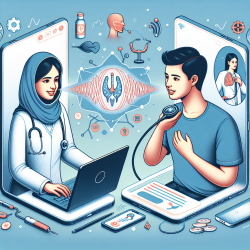The landscape of speech-language pathology is rapidly evolving, with telehealth becoming a significant player in delivering therapeutic interventions. A recent study, Case Reports: Trial Dysphagia Interventions Conducted via Telehealth, published in the International Journal of Telerehabilitation, provides valuable insights into the efficacy of tele-dysphagia interventions. The study examines three case reports, highlighting the potential of tele-dysphagia as a viable method for therapeutic intervention.
Key Findings
The study involved three participants with formal medical diagnoses of dysphagia. Each participated in individual trial intervention sessions conducted via telehealth. The goals focused on training patients to independently use swallowing safety strategies. The strategies included:
- Cyclic Ingestion for Participant 1, promoting swallowing safety by alternating liquids and solids.
- Chin Down Positional Strategy for Participant 2, reducing the risk of aspiration by allowing more time for vocal fold closure.
- Head Rotation Positional Strategy for Participant 3, directing the bolus to the stronger side of the pharynx.
Methodology
The sessions were conducted using the Macintosh FaceTime videoconferencing system and VSee, a HIPAA-compliant telehealth application. Participants were oriented to the equipment and demonstrated the ability to hear audio signals and respond to commands. Each session took place during mealtime, with the clinician providing visual or auditory cues.
Data was collected for the first 30 trials of each session. Participant responses were judged as positive or negative based on their ability to successfully employ the strategy. The effectiveness of tele-dysphagia was measured by the achievement of formal therapy goals, consistent with in-person sessions.
Results
The findings revealed that all participants effectively achieved their formal therapy goals in both in-person and tele-dysphagia sessions. The inter-rater reliability scores, calculated using the Pearson correlation coefficient, indicated a perfect level of agreement between the two raters.
Discussion
Tele-dysphagia has emerged as a promising method for delivering therapeutic interventions. The study's findings provide preliminary evidence supporting its efficacy. However, further research is needed to establish long-term benefits and validate these results across a larger sample size and diverse populations.
Conclusion
The case reports suggest that tele-dysphagia can be a successful delivery method for therapeutic intervention. All three participants achieved their goals and maintained or surpassed their level of achievement during tele-dysphagia sessions. These findings highlight the potential of tele-dysphagia and underscore the need for further research to establish its long-term benefits and broader applicability.
To read the original research paper, please follow this link: Case Reports: Trial Dysphagia Interventions Conducted via Telehealth.










